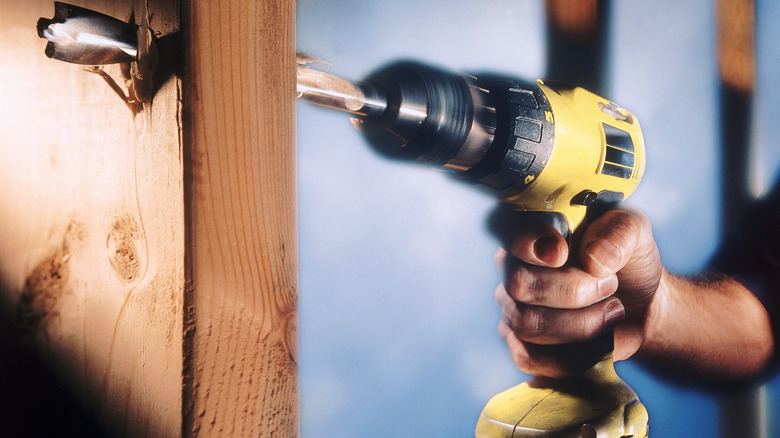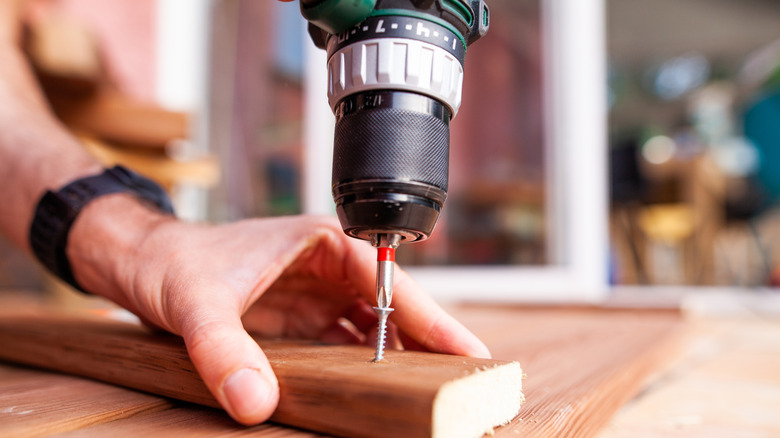4 Common Mistakes When Using A Power Drill (And How To Avoid Them)
In today's world, any homeowner with even a modest amount of knowledge and experience can utilize power tools to construct and repair a variety of things around the home. While a human-powered screwdriver can still come in handy for small tasks, it's difficult to imagine taking on a project without one of the most vital tools in nearly everyone's arsenal: the power drill.
Initially developed back in 1885 by a pair of German mechanics, the first electric drill weighed in at a hefty 16 and ½ pounds. Fast forward to 1962, and Black+Decker debuts the first battery-powered electric drill without a cord. Now, there are several major cordless drill brands that offer contrasts in power, durability, and affordability. Power drills offer even more applications for projects when equipped with useful drill extensions that have nothing to do with drilling. While the fundamental idea of how to use a power drill is self-evident to anyone who has ever picked one up, it doesn't mean that there aren't still some common missteps employed when using one.
For projects big and small, it's important to remember to avoid several common mistakes when using a power drill, such as blocking the motor housing air vents, not drilling a pilot hole, using too much force, and always using the highest torque setting. Fortunately, there are some easy ways to sidestep these basic mistakes and help ensure your project moves forward smoothly.
Hand placement can cause the drill to overheat
One thing you want to look out for when using a power drill is overheating. As the chuck (the twisting portion of the tool) turns, it's normal for a bit of heat to be generated during use. However, overheating isn't something you want to ignore. There are a few symptoms of overheating that are easy to recognize, such as the drill body getting hot and a noticeable burning smell emanating from the power tool.
One of the easiest ways to inadvertently overheat a power drill is to place your hands right over the top of the air vents meant to cool the motor. It's an easy mistake to make, especially when reorienting your hand position due to discomfort or fatigue. This can be especially problematic when wearing gloves since you might not feel the slits in the motor housing or the heat on your hands initially. To prevent blocking the tool's airflow, remember to double-check how you're holding the tool periodically and be cognizant of where the vents are located.
Pilot holes help prevent splitting wood and more
Drilling a pilot hole is a technique in which you select a bit smaller than the fastener you intend to use and drill a hole, removing some of the material prior to installing the screw. You'll want to use this approach when working with hardwoods and laminate or during projects where precision and visual aesthetics are important.
A pilot hole offers several advantages, such as preventing cracks from forming (especially if inserting a screw near the edge of the piece), reducing the effort required to drive a screw through denser material, and helping prevent the fastener from wandering and driving in crooked.
Unfortunately, drilling a pilot hole is an extra step that is often neglected, which ends up compromising the quality and look of a project. There are a few simple indications your task might require drilling pilot holes, such as if you're struggling to break the surface when attempting to drive a screw into the material, if the fastener is near an edge or a narrow portion of the piece, or if the screw placement will be visible and you want to ensure a clean look.
Don't exert too much force by pushing hard into the tool during operation
Even with power tools, projects of all sizes still require some elbow grease to accomplish. However, if you find yourself attempting to use your body weight to pressure a power drill further into the material, something's not right.
If you feel that significant force is required when using the drill, there could be a number of reasons. You may need to drill a pilot hole first, or you may have equipped the wrong bit or a bit that has become dull, or the battery may be degraded, among other things. You'll want to avoid mistakes that are ruining your power tool batteries, which could be responsible for lackluster performance.
Putting too much pressure on a power drill could lead to a trip to the hospital. On average, power drills send around 5,800 people to the emergency room each year. When putting so much force behind the tool in order to drive a screw, there is a lot of pressure on the exceedingly small area of the tip of the bit and the top of the screw. One slip and that power drill can fly forward, striking nearby objects or even puncturing your other hand.
Don't always set the drill torque to its highest setting
When handling your power drill, you may have noticed a series of numbers prior to the chuck that can be adjusted by rotating the clutch and aligning any number with an arrow provided on the top of the tool. Often, you'll see figures from 1 up to 10 or higher, and some power drills also include a drill bit icon in place of a number. This numerical dial allows you to customize the level of torque provided by the drill for any given scenario. The higher the number, the more torque is exerted by the power tool.
While you may be tempted to switch to the maximum torque setting for every project, it's not a good idea. If torque is set too high, you can accidentally drive a screw too far into the material, run the risk of stripping the screw head, and shorten the overall life of your tool.
To preserve your tool and avoid accidents, start with a lower torque option. If it's not enough, the clutch withdraws from the motor, indicating the resistance requires a higher setting. Repeat this process until you are able to adequately sink the fastener to the proper depth without driving in too far.




